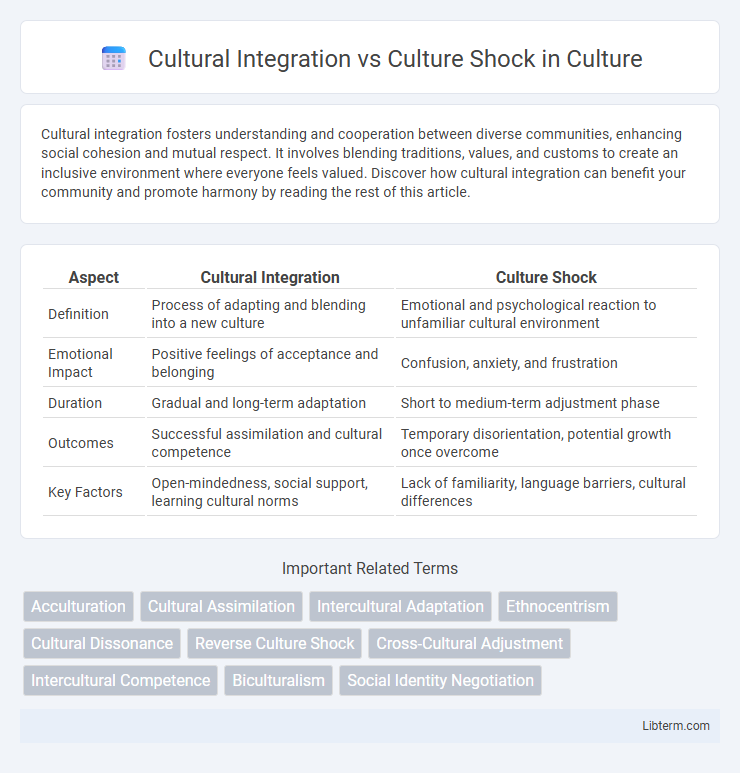Cultural integration fosters understanding and cooperation between diverse communities, enhancing social cohesion and mutual respect. It involves blending traditions, values, and customs to create an inclusive environment where everyone feels valued. Discover how cultural integration can benefit your community and promote harmony by reading the rest of this article.
Table of Comparison
| Aspect | Cultural Integration | Culture Shock |
|---|---|---|
| Definition | Process of adapting and blending into a new culture | Emotional and psychological reaction to unfamiliar cultural environment |
| Emotional Impact | Positive feelings of acceptance and belonging | Confusion, anxiety, and frustration |
| Duration | Gradual and long-term adaptation | Short to medium-term adjustment phase |
| Outcomes | Successful assimilation and cultural competence | Temporary disorientation, potential growth once overcome |
| Key Factors | Open-mindedness, social support, learning cultural norms | Lack of familiarity, language barriers, cultural differences |
Understanding Cultural Integration
Cultural integration involves blending diverse cultural practices and values into a cohesive environment, promoting mutual respect and collaboration. Understanding cultural integration requires recognizing the ongoing process of adaptation where individuals learn, share, and respect differences to create inclusive communities. Successful integration enhances social harmony, reduces conflicts, and supports personal and organizational growth in multicultural settings.
Defining Culture Shock
Culture shock is a psychological and emotional response experienced when individuals encounter a foreign culture significantly different from their own, leading to feelings of confusion, anxiety, and disorientation. It occurs due to challenges in adapting to new social norms, language barriers, and unfamiliar customs, often resulting in stress and homesickness. Understanding the phases of culture shock, including the honeymoon, frustration, adjustment, and acceptance stages, is essential for managing its effects during cultural integration.
Key Differences Between Cultural Integration and Culture Shock
Cultural integration involves the seamless blending of diverse cultural practices, values, and beliefs within a society or organization, promoting mutual respect and understanding. Culture shock refers to the psychological and emotional discomfort experienced when encountering a new or unfamiliar culture, characterized by feelings of confusion, anxiety, and disorientation. The key differences between cultural integration and culture shock lie in their outcomes: integration fosters adaptation and harmony, whereas culture shock signifies initial struggle and adjustment challenges.
Stages of Cultural Integration
Stages of cultural integration typically include the honeymoon phase, where individuals feel excitement and fascination with the new culture, followed by the frustration phase, marked by feelings of confusion and anxiety due to cultural differences. The adjustment phase involves gradual adaptation and learning how to navigate social norms, while the acceptance phase reflects full integration and comfort within the new cultural environment. Understanding these stages helps in effectively managing culture shock and promoting successful intercultural adaptation.
Phases of Experiencing Culture Shock
Culture shock typically unfolds in four phases: the honeymoon phase, marked by excitement and fascination with the new culture; the negotiation phase, where differences in language, customs, and values create frustration and anxiety; the adjustment phase, during which individuals gradually develop coping strategies and gradually feel more comfortable; and the mastery phase, characterized by a sense of belonging and effective cultural integration. Understanding these phases helps in managing emotional responses and enhancing cross-cultural competence. Effective cultural integration occurs when individuals move beyond culture shock, successfully adapting to and embracing the new cultural environment.
Factors Influencing Cultural Adaptation
Factors influencing cultural adaptation include individual personality traits such as openness and emotional resilience, which enable smoother navigation through cultural differences. Environmental elements like social support networks and community inclusivity significantly impact one's ability to integrate into a new culture. Exposure to cultural knowledge and language proficiency further facilitate successful cultural integration, reducing the intensity and duration of culture shock.
Strategies to Ease Culture Shock
Effective strategies to ease culture shock include maintaining open communication with locals and fellow expatriates, which fosters social support and cultural understanding. Engaging in cultural immersion activities such as language classes, community events, and local traditions helps individuals adapt by building familiarity and reducing feelings of isolation. Establishing a routine and setting realistic expectations further enhance psychological adjustment, facilitating smoother cultural integration.
Benefits of Successful Cultural Integration
Successful cultural integration fosters enhanced communication and collaboration within diverse teams, driving innovation and productivity. It promotes mutual respect and understanding, reducing conflicts and creating a harmonious work environment. Embracing cultural differences enriches personal growth and global perspectives, preparing individuals and organizations for a competitive international landscape.
Common Challenges in Cultural Integration
Common challenges in cultural integration include language barriers, differing social norms, and conflicting values that create misunderstandings and hinder effective communication. Immigrants and expatriates often face difficulties adapting to new cultural expectations, leading to feelings of isolation and stress. Overcoming these obstacles requires targeted intercultural training and supportive community programs that facilitate mutual understanding and acceptance.
Tips for Navigating Cross-Cultural Transitions
Effective cross-cultural transitions require embracing cultural integration by actively learning local customs, language, and social norms to foster meaningful connections. Recognizing and managing culture shock symptoms--such as frustration, homesickness, and disorientation--through mindfulness, open communication, and seeking social support accelerates adaptation. Utilizing resources like cultural workshops, expat communities, and local mentors enhances understanding and facilitates smoother adjustment in new cultural environments.
Cultural Integration Infographic

 libterm.com
libterm.com